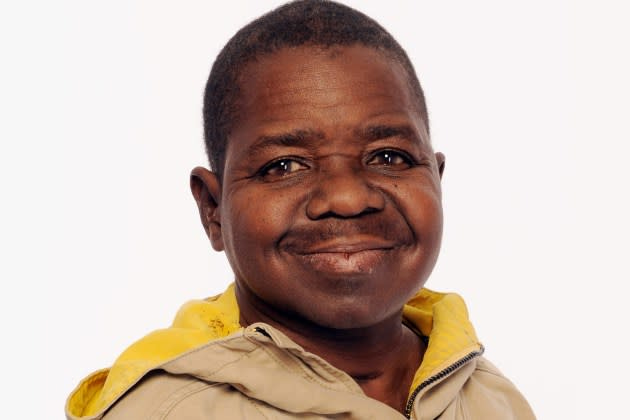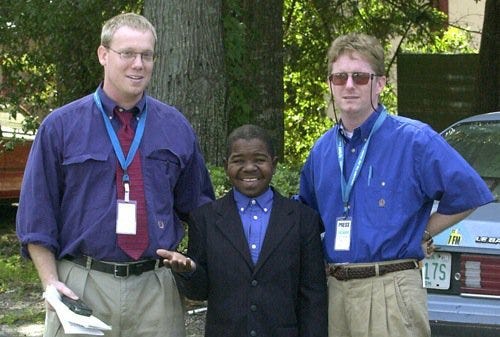Gary
Peacock's documentary on the amazing rise and fall of child actor Gary Coleman occasionally dips into "Inside Edition" type sensationalism, but is a solid, empathetic portrait of a troubled soul.
“Celebrity is always a burden. I don't care who are, I don't care how much you claim you like it. You're stuck with it for life. You're gonna die a celebrity, even if you haven't worked in 20 years.” —Gary Coleman
Hollywood’s list of actors who made a big splash as children and then flamed out in adulthood is long — almost as long as the line of ingenues who found themselves unable to book roles after age 30.
Gary Coleman may have just had the furthest journey from high to low.
From the late 1970s to mid ’80s, he was as big a star on television as there was, with a few feature film roles, too. After “Diff’rent Strokes” ended when he was 18, he became virtually unemployable, outside of a few commercials, bit parts in low-budget productions and occasional walk-ons where he was forced to peddle his faded celebrity by repeating his hated catchphrase, “Whachoo talkin’ bout?!?”
Born with a rare kidney disease that necessitated two transplants and regular dialysis throughout his life, he died in 2010 after a fall resulted in an epidural hematoma. He was 42.
“Gary,” the new documentary about Coleman’s life debuting on the Peacock streaming channel Aug. 29, is a solid and empathetic look at his amazing rise and fall — even if it occasionally indulges in “Inside Edition” type sensationalism.
Two things emerge from this portrait directed by Robin Dashwood: Coleman was a natural-born talent, someone who could light up any room he walked into; and he was fully aware of how others saw him as a washed-up kid actor, a has-been before he was old enough to buy a drink.
Further compounding his trouble, Coleman was badly used by his adoptive parents and business manager, who freely wrote checks to themselves from his earnings and made terrible investments, leaving him virtually broke. He sued them and was awarded damages, but only a tiny trickle of the estimated $18 million he made as a minor was recovered.
At first ready to ditch showbiz after his TV show ended, Coleman soon realized there was little else for which he was qualified. Yet he still had one of the most famous faces in the world — and all the attention, good or bad, that warrants. One encounter with an overly aggressive autograph seeker resulted in him getting arrested and convicted of assault after punching them.
Now he was officially fodder for tabloid magazines and sniggering segments about his troubles on the TV screens where he used to reign.
“He constantly referred to himself as God's punching bag. He felt like one of life's jokes,” says Anna Gray, a onetime love interest and one of Coleman’s few true friends.
Here’s my take on why the transition is so difficult for kid actors. The children who get cast to star in movies and shows at a young age are typically picked because they have hyper-cute faces with pronounced features and big, emotive eyes. These babyish looks tend to carry over to adulthood, making them seem childlike and unserious.
Coleman, with his incredible chipmunk cheeks, still looked 10 even as he approached 20. This of course was compounded by his most noticeable physical trait, a stature of just 4’7” resulting from the kidney treatments he underwent as a very young child.
An imaginative kid who loved science fiction, Coleman dreamed of playing superheroes or villainous roles. But casting directors and filmmakers looked down, quite literally, upon this man-child.
The documentary gathers testimonials from most of the big players in his life, including adoptive parents Willie and Sue Coleman, who seem deeply in denial about their actions; agent Victor Perillo, who saw himself as the protector of Coleman’s career; “Strokes” co-star Todd Bridges, seemingly at peace now after his own post-fame troubles; friend and later agent Dion Mial, simultaneously charismatic and obsequious; and ex-wife Shannon Price, who emerges as the villain of the piece.
Coleman’s romance with Price came during his last few years, meeting her as an extra on the set of a low-budget flick he was starring in. Soon they were married and settled down in Santaquin, Utah, near where the film was shot. She constantly pushed him to do more work, no matter how degrading, to bring in money. Police visits for reports of domestic abuse — both ways — were not uncommon.
The movie gets over its skis in conjecturing about the nature of Coleman’s fatal accident, taking up griping suggestions Price pushed him down the stairs, something the authorities immediately dismissed.
Still, her complete lack of empathy in recounting their relationship is telling, and chilly. She openly confesses to slapping him, but dismisses it as something all couples do. Despite divorcing in 2008, they continued to live together and carry on their antagonism.
Even after their split, she still retained legal power to make medical decisions on his behalf, so at the advice of doctors who claimed Coleman was brain dead, she ordered the life-support machines shut down just two days after his fall.
“Gary” isn’t afraid to show Coleman’s darker side, or portray him as simply a victim of others’ nefarious actions. As his fame grew his head become quite swelled, and Bridges and a “Strokes” hairdresser recall how he would lord it over the rest of the cast and crew, calling himself the star of the show. Even if it was true, imagine being a kid of 12 or 13 with that titanic a sense of entitlement.
I’ll end this review with a personal anecdote. I met Coleman in 2000 and spent the day riding around with him when he came to visit Ocala, Fla., where I was working for Star-Banner newspaper. It was during one of the lowest times of his life, and he had been lured by the young head of a local bioengineering company to come spend the day with his workers and buck them up.
Essentially, he was being paid — $10,000, I think it was — to be their mascot for the day, make jokes, take some pictures, and be famous for being famous. I’m sure it was humiliating for him.
As a dutiful reporter, I asked him about this. Surprisingly, he admitted his shame and confusion at being offered such a gig out of left field. But the harsh truth, he said, is he wasn’t in a position to turn down the money… any money. He struck me as sad, but also smart and quite self-aware.
The photographer accompanying us for the day insisted on taking a snap of me with Coleman and our resident columnist, Dave Schlenker. It was an impromptu moment and not something we asked for. Looking at it now, I feel a little bad about taking it.
Oddly enough, Coleman is the only one in the photo wearing a truly happy expression. When the camera was on him, he was always ready to perform.
It seems clear from “Gary” that he was someone who took the greatest delight in bringing smiles to other people’s faces, and when he was no longer able to do so, he couldn’t shake the frown that invaded his own impossibly cherubic, beautiful face.
Fame is a razor’s edge that, once you fall off it, invariably cuts.





Good review, Chris. I'm curious though, about doctors who "claimed" he was brain-dead. Was there a question or controversy about that?
First class review, I will be watching the documentary as a result of this . What really resinated with me was this “Oddly enough, Coleman is the only one in the photo wearing a truly happy expression. When the camera was on him, he was always ready to perform.”
Seems like despite his early fame he like a lot of child stars was deeply unhappy and messed up.
I just cannot fathom why parents still want to push their kids into film and television.